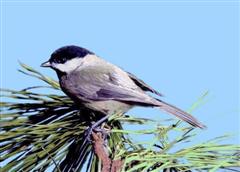Chickadee - Carolina
Scientific Name: Parus carolinensis
Fri, 1st November, 2024 - 8:20 am GMT
Sponsor Ads:

Alternative Name
Scientific Name: Parus carolinensisBasic Info
Only reaching about four and a half inches in length, the Carolina Chickadee is the smallest North American Chickadee! The plumage is predominantly gray, and may be a darker shade of gray over the tail and wing areas of the bird. Unlike Black Capped Chickadees, Carolina Chickadees lack broad white banding over their wings. Usually, the underside is white. Carolina Chickadees have black caps and bibs, and contrasting white cheeks! Their bibs are quite well defined. The areas about this chickadee's flanks are usually gray or buff colored.
Health
Usually, Carolina Chickadees may be attracted to people's backyards by the setting out of suet or seeds! Special favorites include pine, sunflower, redbud, mulberry, and ragwood, although they may also eat certain insects. Breeding Carolina Chickadees breed in nesting boxes, but in the wild, any cavity or woodpecker hole of sufficient construction may be used. Usually, a clutch of five to eight eggs is produced, and the eggs will incubate for about 14 days. These little chickadees will leave the nest when they are about two and a half weeks old, and both parents aid in raising the little birds.Habitat
N/ABehavior
Although frequently mistaken for the Black Capped Chickadee, the Carolina Chickadee is a charming little bird that deserves individual recognition! These beautiful animals are a favorite among many, from naturalists to amateur backyard bird feeding hobbyists! The lovely song of the Carolina Chickadee allows it to be distinguished from other birds, and usually consists of a four-note pattern. Usually, a "fee-bee fee-bay" sound is produced. It is said that the last notes of the characteristic "chick-a-dee-dee" call may be a bit more harsh in pronunciation than those of other Chickadees. These little birds will readily associate with other birds and may even become quite tame toward people who feed them! They are very active and show highly acrobatic flying displays from time to time. Carolina Chickadees roost in cavities in dead or dying trees, or in nesting boxes provided to them by man! In very cold weather, such cavities fill with their body heat to keep them warm for extended periods of time. Carolina Chickadees normally do not migrate. They generally eat seeds and small insects.Origin
North AmericaHistory
Carolina Chickadees inhabit the southeastern regions of the United States. Their range overlaps with that of the Black Capped Chickadee, and the two may produce hybrid offspring. Although Carolina Chickadees are quite popular with enthusiasts who like to feed the little birds and can even teach them to eat from their hands, the population may be declining. This is due to the removal by man of the rotting or dead trees that the birds nest in.Common Foods
N/ASponsor Ads:
The secret of success is sincerity. Once you can fake that, you've got it made. -- Unknown
Chickadee - Carolina
Coded by: BGID® | ALL RIGHTS RESERVED Copyright © 2000-2024
Disclaimer | Privacy | Report Errors / Contact | Credits
















